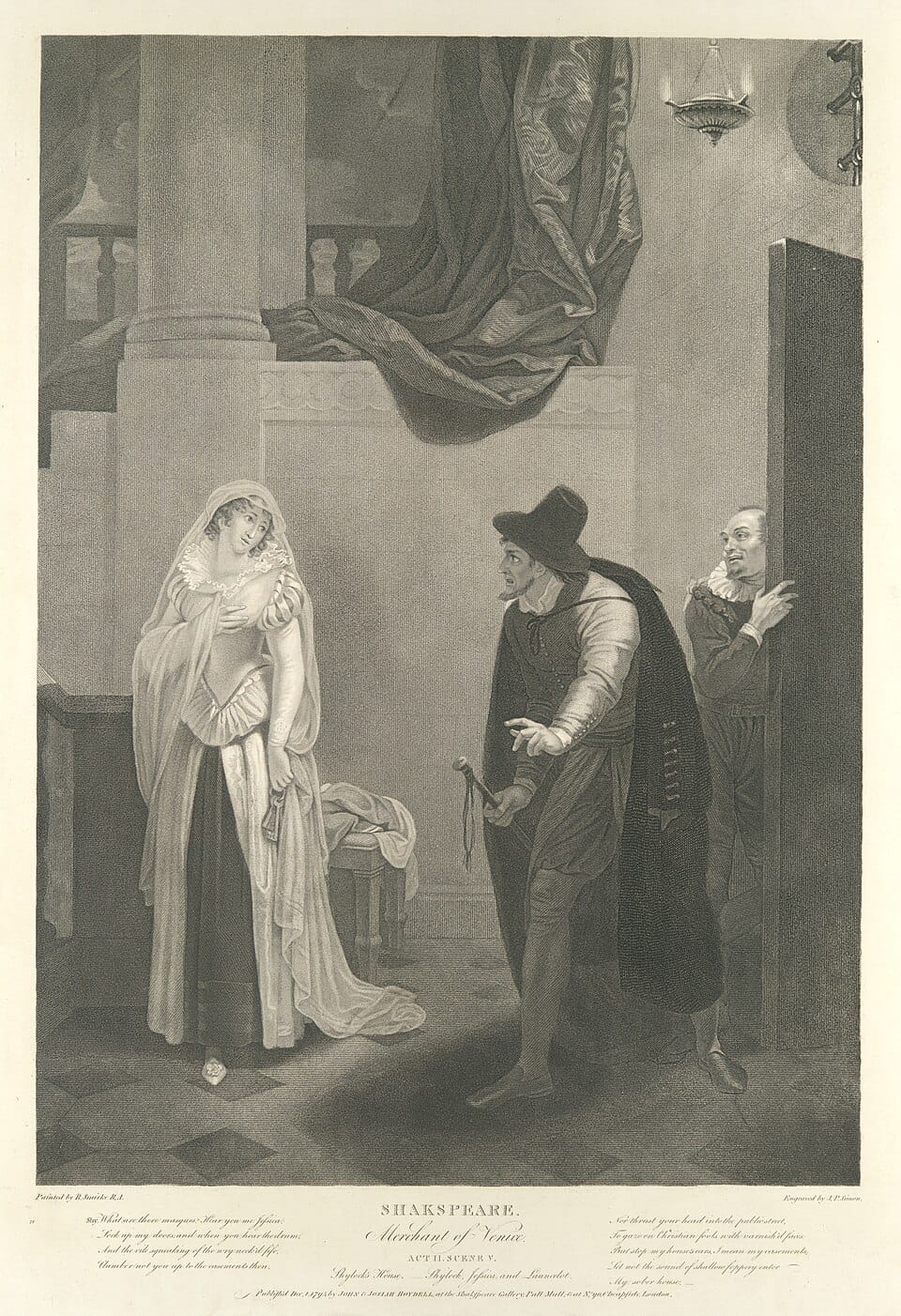Revisiting Shakespeare: “The Merchant of Venice”
Senior Managing Editor Edwyn Choi ’27 examines the thorny legacy of Shylock, the Venetian moneylender who’s made more modern headlines than some would like to admit. From dodging a literal “pound of flesh” to debates over antisemitism, “The Merchant of Venice” refuses to retire quietly.

Earlier this year, President Donald Trump drew criticism from several Jewish organizations after using the name “Shylock” to refer to corrupt bankers and financial institutions. Several years before that, then-President Joe Biden also used the same name to describe greedy and unscrupulous moneylenders.
A Venetian Jewish moneylender, Shylock is a character from this week’s play, which is arguably Shakespeare’s most controversial work: “The Merchant of Venice.” Shylock is ostensibly the central villain of the play, written to embody all the harmful stereotypes associated with Jews throughout history: usury, greediness, and legalism (a strict adherence to the law, even if it might not lead to justice), among others.
While both Biden and Trump eventually apologized for using the name in their respective speeches, their slip-ups indicate that “Shylock” became something of a general term for describing a predatory moneylender of any ethnic identity (Trump himself later said he had never heard the term in an antisemitic context). The name’s use as a general term demonstrates the stain “The Merchant of Venice” has left on our culture and reopens old wounds that span across centuries — notably, the play was appropriated by Nazi Germany for propaganda needs.
Despite this stain, the play hasn’t faded into obscurity like some of Shakespeare’s other works have (cough cough “Measure for Measure”). Directors, performers, and writers continue to revisit the play to this day, despite — or perhaps because of — its rampant antisemitism, from Howard Jacobson’s 2016 novel, “Shylock is My Name,” to Al Pacino’s portrayal of Shylock in both Michael Radford’s 2004 film and the Public Theater’s 2010 production.
But why? Why do we still stage the play, which is often lumped in with the rest of Shakespeare’s comedies? Why do we continue giving it our attention?
It’s my hope that I can help you answer some of these questions by breaking down the key themes and elements of “The Merchant of Venice.”
Contrary to what many people think, the title “The Merchant of Venice” doesn’t actually refer to Shylock himself. Instead, it refers to Antonio — a wealthy Christian moneylender in Venice. Antonio’s friend, Bassanio, wants to woo Portia, a wealthy heiress from Belmont (a fictional location in rural Italy), but can’t afford anything to impress her. Antonio agrees to bail Bassanio out, as he’s done before — but all of Antonio’s money is tied up in ships currently at sea. Nevertheless, Antonio promises to cover Bassanio’s loan if he can find another lender. Bassanio chooses Shylock, who is initially reluctant to work with Antonio since he believes Antonio “hates [their] sacred nation” (“nation” referring to Jews at large, not a country), has antagonized Shylock for usury, and “lends out money gratis and brings down / The rate of usance here with us in Venice” (1.3). Shylock eventually agrees — even lending money without interest — but only on one condition:
“If you repay me not on such a day,
In such a place, such sum or sums as are
Expressed in the condition, let the forfeit
Be nominated for an equal pound
Of your fair flesh, to be cut off and taken
In what part of your body pleaseth me” (1.3).
It’s from this play, by the way, that the term “pound of flesh” originates. Since this is a Shakespeare play, and there’s a need for drama, you can predict what’s going to happen: Antonio isn’t able to liquidate his money, meaning he defaults on the loan, so Shylock’s condition kicks in. Skip a couple of acts, and you get to the infamous trial scene in Act 4, Scene 1, where Shylock argues for his “pound of flesh” in court while Antonio’s friends beg for mercy.
If there’s one way to summarize my experience reading this play, it felt like I was waiting for the trial scene to eventually come. Everything else, if I’m being honest, either feels lackluster or like preparation work for the trial — the only other scene “The Merchant of Venice” is known for is the “three caskets” scene, where Portia’s father’s will has determined that the suitor who picks the casket with Portia’s portrait will become her husband (I promise there’s a logic to this, but that’s beyond the purview of this column).
Whether that waiting game is worthwhile is up to you. What I am certain about, though, is that the trial scene is one of the tensest climaxes out of any of Shakespeare’s plays, where you can feel the anxiety in the courtroom as Shylock eagerly sharpens his knife (literally, on his shoe). But the play then hits you with an uppercut: You feel the tension because you care about Antonio and his friends, who are antisemites.
This leads me to the elephant in the room, which is the play’s disgusting characterization of Shylock. He is presented not only as greedy but also as hateful and bloodthirsty. He is the scourge that the play’s Christian characters must defeat at all costs. Despite this characterization, Shylock also has one of the play’s most moving soliloquies, where he argues that he should be treated as an equal — with that equality encompassing the right to revenge:
“Hath not a Jew eyes? Hath not a Jew hands, organs, dimensions,
senses, affections, passions? …
… If a Jew wrong a Christian,
what is his humility? Revenge. If a Christian
wrong a Jew, what should his sufferance be by Christian
example? Why, revenge! The villainy you teach me I
will execute, and it shall go hard but I will better the
instruction” (3.1).
Then what do we make of the trial’s outcome, where (spoiler alert) the judge who nullifies Shylock’s “pound of flesh” is actually Portia, whom Bassanio has just wooed? And what do we make of Shylock’s forced conversion to Christianity at the end of the trial? How should we, as audiences, reconcile Shylock’s abject fate with the sympathy that Shakespeare had given him earlier? These, among other injustices Shylock suffers throughout the play, illustrate an internal confusion: The play cannot decide whether Shylock is a villain or a victim.
It is this ambiguity that has invited so many scholars and artists to dwell on “The Merchant of Venice” to this day. One critical text is James Shapiro’s “Shakespeare and the Jews,” which explores Elizabethan attitudes toward Jewish (and English) identity in relation to Shakespeare’s play. In a post-Holocaust world, many scholars have continued focusing on the play’s antisemitism, such as Derek Cohen’s “Shylock and the Idea of the Jew.”
However, some approaches to the play turn away from this mode of analysis — Sigmund Freud’s 1913 essay, “The Theme of the Three Caskets,” is one example. More recently, some scholars have argued that we risk missing other, equally generative parts of the play if we focus strictly on its antisemitic properties. In her 2022 book “Reading Shakespeare in Jewish Theological Frameworks: Shylock Beyond the Holocaust,” Caroline Wiesenthal Lion maneuvers around the Holocaust’s shadow by focusing on the play’s relationship to Jewish theology instead. The book’s abstract explains that we can “see beyond the racism in Shakespeare’s plays by recovering Shakespearean themes of potentiality and human flourishing as they emerge within the Jewish tradition itself.”
As for performances, the college has access to the Royal Shakespeare Company’s 2015 production of the play (directed by Polly Findlay), although I’m obligated to remind you again of Michael Radford’s 2005 film adaptation, in which Al Pacino portrays Shylock, as well as Howard Jacobsen’s novel, “Shylock is My Name.” There’s also Mark Leiren-Young’s one-act monologue play “Playing Shylock,” which wrestles with Shakespeare’s antisemitic portrayal of the moneylender and is currently being performed at Brooklyn’s Polonsky Shakespeare Center until December — the monologue is set right after a production of “The Merchant of Venice” is canceled midway due to public cries over antisemitism.
Shakespeare’s text has also garnered attention globally, with Taiwanese director Lü Po Shen adapting the plot for his 2009 production “Bond” and Korean director Sohn Jin Chaek combining Shylock’s plot with the romance of “Romeo and Juliet” to create his 2005 production “The Merchant Hwang of Mapo.” These examples, as well as others, demonstrate how Shakespeare’s work continues to be remixed and adapted as a global phenomenon.
“The Merchant of Venice” is many things at once: a ghost whose linguistic stains still haunt us today, a battleground for debate over Jewish identity beyond the Holocaust, and a way for Jewish artists to reclaim their authority through art. If there’s a way to experience “The Merchant of Venice” despite all its problems, it’s to embrace the play’s ambiguity — it’s precisely because of its confusion, both in how it treats Shylock and its broader place in history, that we return to the play over and over again.




Comments ()